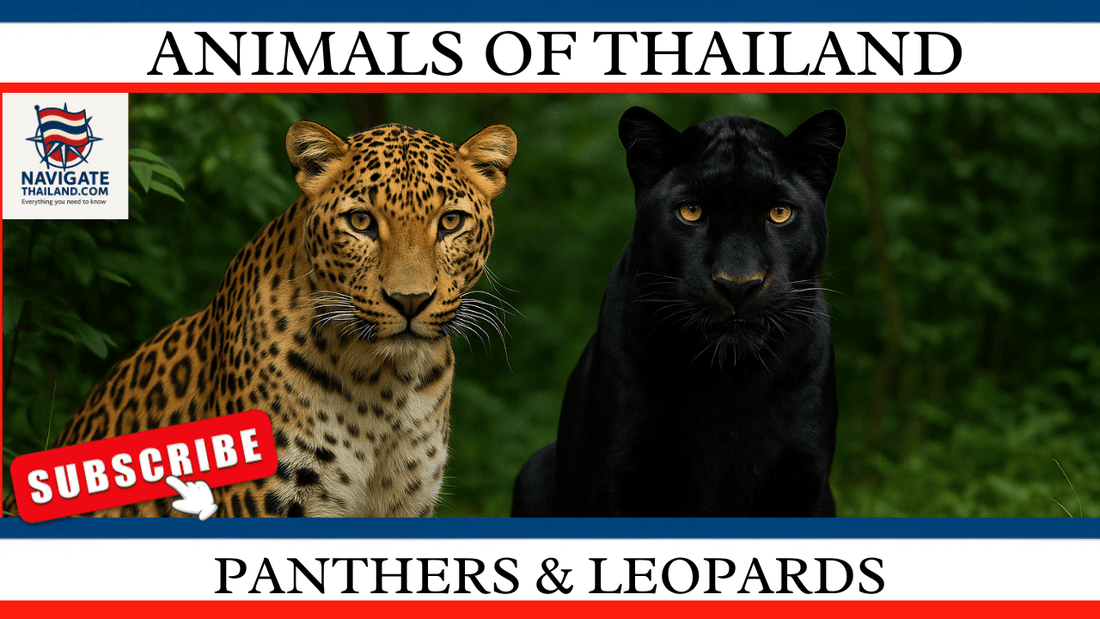
Panthers & Leopards in Thailand: Everything You Need to Know
Share
Panthers and leopards are among the most captivating and mysterious creatures of the wild. In Thailand, these big cats play an integral role in the country’s biodiversity, evoking awe among nature lovers and wildlife enthusiasts. However, the term “panther” often leads to confusion, as it can refer to both black leopards and other big cats depending on the region. In Thailand, the “panther” refers to black leopards—melanistic leopards that appear entirely black due to a genetic mutation.
This in-depth blog will explore everything you need to know about panthers (black leopards) and leopards in Thailand, including their characteristics, habitats, behaviour, threats, and conservation efforts. Additionally, we’ll look at their cultural significance and the crucial role they play in maintaining the ecological balance of Thailand’s forests.
What Are Panthers and Leopards?
Leopards: The Species Overview
Leopards (Panthera pardus) are one of the five big cats belonging to the genus Panthera, which also includes lions, tigers, jaguars, and snow leopards. Known for their sleek, muscular bodies and iconic spotted coats, leopards are highly adaptable predators found in a variety of habitats, from forests and grasslands to mountainous regions.
Leopards in Thailand are part of the Indochinese leopard subspecies (Panthera pardus delacouri), which is native to Southeast Asia. Their coats are covered in dark spots or “rosettes,” which help them camouflage in their environment, making them stealthy hunters.
Panthers in Thailand: Black Leopards
When we talk about panthers in Thailand, we are actually referring to melanistic leopards—leopards with a genetic mutation that causes an overproduction of melanin, resulting in an all-black coat. Despite their dark colouring, black leopards still possess the distinctive rosette patterns that are visible in bright light. These black leopards are commonly called “panthers” in local Thai vernacular.
While melanistic leopards are not a separate species from regular leopards, their striking appearance has earned them a unique place in local culture and folklore. Thailand’s forests are home to both spotted and black leopards, with black leopards being rarer and more elusive.
Habitat of Panthers and Leopards in Thailand
Leopards, including black leopards (panthers), inhabit some of the most remote and wild regions of Thailand. Their primary habitat is the dense forests and mountains of western Thailand, particularly in the Western Forest Complex, a vast stretch of protected forest land that borders Myanmar.
The Western Forest Complex
This region, spanning over 18,000 square kilometres, is one of the largest forested areas in Southeast Asia. It includes several national parks and wildlife sanctuaries, such as the Huai Kha Khaeng Wildlife Sanctuary and Thungyai Naresuan Wildlife Sanctuary, both of which are UNESCO World Heritage Sites. These protected areas are crucial for the survival of many endangered species, including leopards, tigers, elephants, and gaur.
The thick vegetation, abundant prey, and relatively low human interference in the Western Forest Complex make it an ideal environment for leopards and black panthers. Other areas where leopards have been spotted include Khao Sok National Park and Khao Yai National Park, though sightings are rare due to the animals’ elusive nature.
Habitat Preferences
Leopards in Thailand prefer areas with dense cover, such as rainforests, mixed deciduous forests, and hilly or mountainous regions. They are highly adaptable and can live in a range of habitats, as long as there is sufficient prey and adequate cover for hunting. Leopards are skilled climbers, and their ability to drag prey up trees to avoid scavengers gives them a distinct advantage in forests.
Leopards are solitary animals, with each individual maintaining a defined territory. These territories can overlap between males and females, but male territories rarely overlap with those of other males. Leopards mark their territories using scent markings, urine spraying, and scratch marks on trees.
Behaviour and Characteristics of Leopards and Black Panthers
Leopards and black panthers are incredibly agile and powerful animals. Despite their solitary nature, they are opportunistic hunters and highly adaptable to changes in their environment.
Physical Characteristics
Leopards are medium-sized big cats, with males typically weighing between 45 and 90 kg, and females between 30 and 60 kg. They are known for their muscular build, short legs, and long, flexible tails that help them maintain balance while navigating trees and dense vegetation.
Leopards have unique coat patterns, with rosettes covering their body. These rosettes vary in size and shape depending on the individual, and are an excellent form of camouflage. Black leopards, or panthers, possess the same rosette patterns, but these are masked by their dark fur.
Fun Fact: Despite their dark coats, black panthers still have spots that are faintly visible under certain lighting conditions, especially in direct sunlight.
Hunting and Diet
Leopards are apex predators and play a critical role in controlling the populations of herbivores in their habitat. They are ambush predators, relying on stealth and patience to catch their prey. Leopards typically hunt at night, which allows them to take advantage of their dark coats (in the case of black panthers) to blend into the surroundings.
Their diet consists mainly of deer, wild boars, monkeys, and small mammals, though they are known to hunt birds, reptiles, and even smaller predators like foxes. Leopards can take down prey much larger than themselves due to their strength and powerful jaws. One of their most impressive hunting techniques is their ability to drag their kills up into trees to protect them from scavengers such as hyenas and wild dogs.
Nocturnal and Solitary Behaviour
Both regular and black leopards are largely nocturnal, meaning they are most active during the night. They spend their days resting in dense vegetation or up in trees, away from the heat and human activity. Their nocturnal behaviour makes them difficult to spot, even in areas where they are known to reside.
Leopards are solitary animals, and apart from mothers with cubs, they are rarely seen together. Their territories can be large, and males may cover a greater area than females. They communicate with each other through roars, scent marking, and claw marks on trees.
Threats to Leopards and Black Panthers in Thailand
Leopards, including black panthers, face numerous threats in Thailand that have led to a decline in their populations. As human activity continues to encroach on their natural habitats, leopards are becoming increasingly vulnerable.
Habitat Loss and Fragmentation
The most significant threat to leopards in Thailand is habitat loss due to deforestation, agricultural expansion, and urban development. As forests are cleared for farming or infrastructure, leopards are pushed into smaller and more isolated patches of habitat. This fragmentation makes it more difficult for them to find food, reproduce, and avoid human contact.
The Western Forest Complex remains one of the last strongholds for leopards in Thailand, but even this region is not immune to the pressures of deforestation and illegal logging.
Poaching and Illegal Wildlife Trade
Poaching is a major threat to leopards in Thailand. Despite being protected by law, leopards are still hunted for their pelts, bones, and other body parts, which are sold on the black market. The illegal wildlife trade, driven by demand for exotic animal products, has had a devastating impact on leopard populations.
High-profile incidents, such as the infamous case of a black panther being hunted by a prominent businessman in Thungyai Naresuan Wildlife Sanctuary, have drawn attention to the severity of poaching in Thailand. Despite increased efforts to crack down on illegal hunting, poaching continues to pose a serious threat to the survival of leopards.
Human-Wildlife Conflict
As human populations expand into leopard habitats, encounters between leopards and people are becoming more frequent. In rural areas, leopards may prey on livestock, leading to conflict with farmers who sometimes retaliate by killing the leopards. This human-wildlife conflict is exacerbated by the shrinking availability of natural prey in fragmented habitats.
Conservation Efforts to Protect Leopards in Thailand
While the situation for leopards and black panthers in Thailand is critical, there are ongoing conservation efforts aimed at protecting these majestic animals and their habitats.
National Parks and Wildlife Sanctuaries
Thailand has designated several national parks and wildlife sanctuaries to protect endangered species, including leopards. The Western Forest Complex is one of the most important conservation areas in the country, as it provides a large, contiguous habitat for leopards and other big cats.
Within these protected areas, rangers patrol the forests to prevent poaching and monitor wildlife populations. The Department of National Parks, Wildlife and Plant Conservation (DNP) works alongside NGOs and local communities to ensure that these areas remain safe for leopards and other species.
Anti-Poaching Initiatives
To combat poaching, Thailand has increased penalties for those caught hunting endangered species. Anti-poaching patrols, equipped with modern technology such as drones and camera traps, have been deployed in national parks to detect and prevent illegal hunting activities. Additionally, there has been a growing emphasis on community involvement in conservation, with local communities being trained to protect wildlife in their regions.
Fun Fact: In some regions of Thailand, local people refer to leopards as “ghost cats” due to their elusive nature and ability to vanish into the jungle.
Ecotourism and Education
Ecotourism plays an important role in raising awareness about the importance of protecting wildlife. In areas like Khao Yai National Park and Huai Kha Khaeng, eco-friendly wildlife tours offer visitors the chance to see leopards and other animals in their natural habitat. These tours not only generate income for local communities but also promote the value of conservation.
Education programs aimed at raising awareness about the plight of leopards are also being implemented in schools and communities near leopard habitats. By fostering a deeper understanding of these animals, conservationists hope to reduce human-leopard conflicts and protect leopard populations for future generations.
Cultural Significance of Leopards in Thailand
Leopards, including black panthers, hold a special place in Thai folklore and culture. Historically, these animals have been symbols of strength, stealth, and resilience. In some rural communities, leopards are seen as protectors of the forest, and their presence is thought to bring balance to the ecosystem.
In traditional Thai beliefs, the leopard is often associated with spirits and guardians of the jungle. Seeing a leopard in the wild is considered a rare and powerful experience, as these elusive creatures are seen as masters of camouflage and survival.
Conclusion
Leopards and black panthers are integral to Thailand’s rich biodiversity, playing a vital role in maintaining the balance of their ecosystems. Despite facing numerous threats, including habitat loss, poaching, and human-wildlife conflict, conservation efforts are making a difference in protecting these majestic big cats. By raising awareness and promoting sustainable practices, Thailand is taking steps to ensure the survival of its leopard populations for future generations.
While leopards remain elusive and difficult to spot in the wild, their presence in Thailand’s forests is a reminder of the country’s incredible natural heritage and the importance of conservation efforts to protect these beautiful animals.
References:
1. National Geographic – “Leopards: The Stealthy Cats of Southeast Asia”
2. Department of National Parks, Wildlife and Plant Conservation (DNP), Thailand
3. World Wildlife Fund (WWF) – “Conservation Efforts in Southeast Asia”
4. Wildlife Conservation Society (WCS) Thailand – “Protecting Big Cats”
5. UNESCO World Heritage – “The Western Forest Complex and Its Biodiversity”
Read more of our Thailand blog series:
Thai Food Guide:Traditional Recipes and Street Eats
Everything Travellers Need to know
Thailand travel ebooks and language guides
Thailand Travel Apparel & Souvenir Gifts
Subscribe to our YouTube channel Navigate Thailand to see our most popular Thailand travel blogs turned into videos:
Navigate Thailand YouTube channel


















































































































































